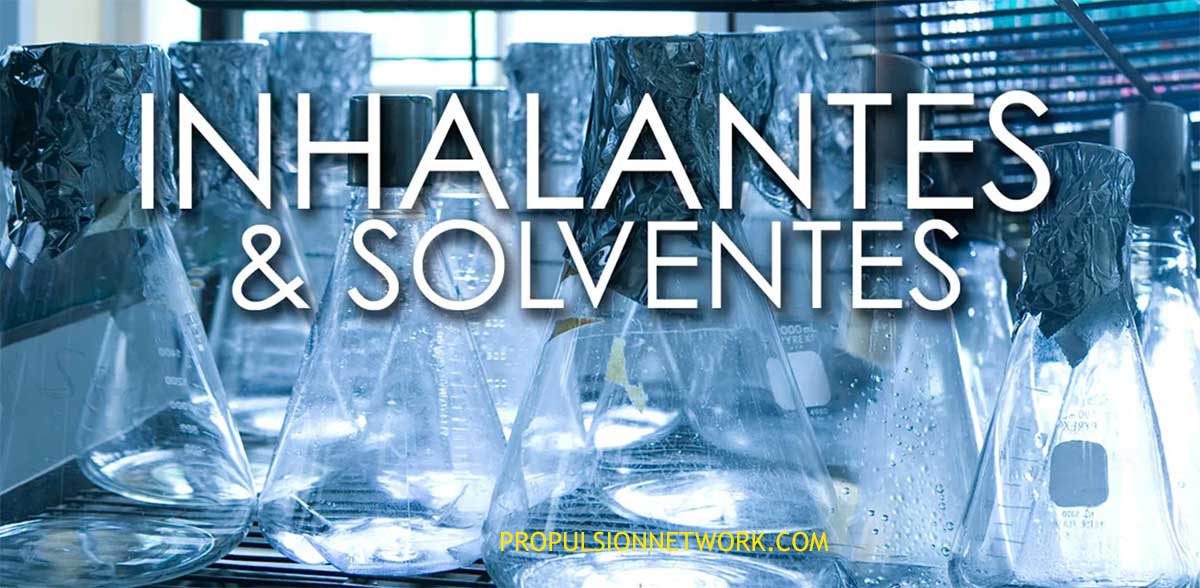Inhalants & solvents ENGLISH
What are solvents?
(Trichloethylene, tetrachlorethylene, ethyl acetate, acetone, toluene, benzene, methylene chloride)
Commonly known as Cement, Chemo, Mona, Active, Glue, Resistol, PVC, Gasoline, Thinner, etc. are
depressants these substances are generally called solvents because of their ability to dissolve other compounds. Active solvents have the function of diluting non-water-soluble substances. They can be bought in hardware stores, tlapalerías or self-service stores, they are relatively inexpensive and the doses in the street can be obtained easily. However, none of these substances are produced for human consumption purposes. They are work tools in different trades and serve industrial purposes.
Effects edit
The effect of any solvent begins a few minutes after being inhaled and ends approximately one hour after the last inhalation. Although their mechanisms of action are different, they all act by depressing the Central Nervous System in a similar way to alcohol.
Generally, reflexes can decrease, they can cause nausea, dizziness and disorientation. In cases of severe intoxication, language disorders, muscle weakness, involuntary oscillation of the eyes, delusions and occasionally hallucinations with altered behaviors that can cause violent states in the person can appear. To these effects are added a series of mental states that range from disinhibition and feelings of lightness, euphoria and well-being, to visual distortions and severe modifications in mental processes.
These effects are related to the toxicity of these substances. A few hours after the effects start, a hangover or “hangover” appears with headaches, disorientation, loss of coordination and dizziness. This progressively worsens as consumption is sustained or increased. In a short time, the damage to the nervous tissue is irreparable and the impacts become practically permanent.
What are your risks?
There are many risks related to the consumption of inhalants, which change depending on the type of product and can manifest themselves from the practical, such as the glue or cement bag sticking around a person’s mouth, to the appearance of burns. and abrasion sores when using thinner or white spirit.
The main risk is general for all these substances and has to do with damage to cells of the nervous system: neurons. Communication between these cells is possible thanks to the fact that they are covered with a substance called myelin, a type of fat, which allows cells to modify their electrical conduction properties and to be able to carry messages from one point to another.
With the consumption of these products, the myelin sheath deteriorates in all neurons around the body (central, peripheral, sensory and motor), wearing down to the point where it is no longer possible for them to carry the electrical signal to its destination. , which is summarized in a progressive deterioration in motor skills and coordination, general sensitivity and the ability to concentrate or perform complex processes. These substances are so aggressive for the body that the consequences of their consumption quickly become irreversible and permanent.
Are inhalants addictive?
Since its effects involve an alteration of brain processes, including various areas involved with pleasure, a habituation and psychological dependence can form. In addition to this, they generate a strong tolerance, so that over time it is necessary to increase the inhalation time to reach states similar to the first experiences. This causes an increase in the impact on the body and directly affects its deterioration.
Legality
It is legal to buy these types of products anywhere. In places like Mexico City there are certain regulations such as presenting identification or proof of age. In general, if the police find you carrying these substances and think they are for inhaled consumption, they can confiscate them, even leading to arrest if they find you intoxicated or consuming on public roads under the charge of moral offenses or vagrancy and begging, but never on the charge of consuming an illegal narcotic.
Damage reduction
These products are not for human consumption. These substances when they enter the body, cause strong and rapid damage. For this reason, we strongly discourage its use as a substance to alter consciousness. If you plan to use these substances or know someone who does or plans to do so, here are some tips that can help avoid difficult situations and even save lives:
Translation types
Text translation
Source text
1,439 / 5,000
Translation results
• Never smoke tobacco during or immediately after inhaling. Many of these substances are highly volatile, can easily catch fire, and can become impregnated on hands, face, and clothing.
• Try not to inhale in closed spaces, the vapors of these substances are trapped and you can overdose simply by being indoors. If you can’t avoid being indoors, always try to keep the door and windows open to help fumes escape. Verify that neither you nor the other people lie down or remain seated near the ground level, since these vapors are heavier than air, they remain in the lower part of the room and cannot be ventilated. Being at ground level can cause a poisoning similar to having the room closed completely.
• Seek to hydrate well and eat as much as possible, otherwise, the deterioration and impact caused by these substances on the body will be much greater and will appear quickly.
• Try to spend as much time as possible between each time you consume, in this way, you give your body a greater opportunity to process all the toxic waste that these substances cause when passing through the body. The kidneys and liver are the first organs to fail due to the burden caused by detoxifying the body of these wastes. The best thing you can do is DO NOT EAT THEM.
¿Qué son los solventes?
(Tricloetileno, tetracloroetileno, acetato de etilo, acetona, tolueno, benceno, cloruro de metileno)
Comunmente conocidos como Cemento, Chemo, Mona, Activo, Pegamento, Resistol, PVC, Gasolina, Thinner, etc. son
depresores a estas sustancias se les llama por lo general solventes por su capacidad de disolver otros compuestos. Los solventes activos tienen como función diluir sustancias no hidrosolubles. Se pueden comprar en ferreterías, tlapalerías o tiends de auto-servicio, son relativamente económicos y las dosis en la calle se pueden adquirir fácilemnte. Sin embargo, ninguna de estas sustancias se produce con fines de consumo humano. Son herramientas de trabajo en diferentes oficios y cumplen propósitos industriales.
 Efectos
Efectos
El efecto de cualquier solvente comienza unos inutos después de haber sido inhalado y finaliza aproximadamente una hora después de la última inhalación. Aunque sus mecanismos de acción son diferentes, todas actúan deprimiendo el Sistema Nervioso Central en forma similar al alcohol.
Generalmente pueden disminuir los reflejos, pueden provocar nauseas, mareos y desorientación. En casos de intoxicación severa pueden aparecer alteraciones del lenguaje, debilidad muscular, oscilación involuntaria de los ojos, delirios y ocasionalmente alucinaciones con conductas alteradas que pueden llegar a provocar estados violentos en la persona. A estos efectos se les añade una serie de estados mentales que van desde la desinhibición y las sensaciones de ligereza, euforia y bienestar, hasta distorsiones visuales y modificaciones severas en los procesos mentales.
Dichos efectos están relacionados con la toxicidad de estas sustancias. Unas horas después de que inician los efectos, aparece una resaca o “cruda” con dolores de cabeza, desorientación, pérdida de coordinación y mareos. Esto empeora progresivamente a medida que se sostiene o aumenta el consumo. En poco tiempo, el daño al tejido nervioso es irreparable y los impactos se vuelven prácticamente permanentes.
¿Cuáles son sus riesgos?
Existen muchos riesgos relacionados con el Consumo de inhalables, los cuales cambian dependiendo el tipo de producto y pueden manifestarse desde lo práctico, como que la bolsa de pegamento o de cemento se quede pegada alrededor de la boca de una persona, hasta la aparición de quemaduras y llagas por abrasión al utilizar thinner o aguarrás.
El principal riesgo es general para todas estas sustancias y tiene que ver con el daño a células del sistema nervioso: las neuronas. La comunicación entre estas células es posible gracias a que están cubiertas con una sustancia llamada mielina, un tipo de grasa, que le permite a las células modificar sus propiedades de conducción eléctrica y poder conducir los mensajes de un punto a otro.
Con el consumo de estos productos, la cubierta de mielina se va deteriorando en todas las neuronas alrededor del organismo (centrales, periféricas, sensoriales y motoras), desgastándose hasta el punto en el que ya no les es posible llevar la señal eléctrica a su destino, lo cual se resume en un deterioro progresivo en la motricidad y la coordinación, la sensibilidad en general y la capacidad de concentrarse o realizar procesos complejos. Estas sustancias son tan agresivas para el cuerpo, que las consecuencias de su consumo se tornan rápidamente irreversibles y permanentes.
¿Los inhalantes son adictivos?
Ya que sus efectos involucran una alteración de los procesos del cerebro, incluyendo diversas áreas involucradas con el placer, se puede formar un habituamiento y una dependencia psicológica. Además de esto, generan una fuerte tolerancia, por lo que con el tiempo se necesita aumentar el tiempo de inhalación para llegar a estados similares a las primeras experiencias. Esto provoca un incremento en el impacto en el impacto al organismo y afecta directamente en su deterioro.
Legalidad
Es legal comprar este tipo de productos en cualquier lugar. En lugares como la Ciudad de México hay ciertas regulaciones como presentar identificación o comprobante de mayoría de edad. Por lo general, si la policía te encuentra portando dichas sustancias y piensa que son para el consumo inhalado, puede confiscarlas, llegando incluso al arresto en caso de encontrarte intoxicado o consumiendo en la vía pública bajo el cargo de faltas a la moral o vagancia y mendicidad, pero nunca bajo el cargo de consumo de un narcótico ilegal.
Reducción de daños
Estos productos no son para consumo humano. Estas sustancias cuando se introducen en el cuerpo, provocan daños fuertes y de manera rápida. Por esto, desaconsejamos fuertemente su uso como sustancia para alterar la conciencia. Si piensas utilizar estas sustancias o conoces a alguien que lo haga o piense hacerlo, estos son algunos consejos que pueden ayudar a evitar situaciones difíciles e incluso salvar vidas:
• Nunca fumes tabaco durante o inmediatamente después de inhalar. Muchas de estas sustancias son altamente volátiles, pueden prenderse en llamas fácilmente y pueden quedarse impregnadas en las manos, en la cara y en la ropa.
• Trata de no inhalar en espacios cerrados, los vapores de estas sustancias se quedan atrapados y se puede sufrir una sobredosis simplemente por estar adentro. Si no puedes evitar estar en interiores, intenta tener siempre la puerta y las ventanas abiertas para facilitar que se vayan los vapores. Verifica que ni tú ni las otras personas se recuesten o permanezcan sentadas cerca del nivel del suelo, pues al ser más pesados estos vapores que el aire, se quedan en la parte inferior del cuarto y no logran ventilarse. Estar a nivel del suelo puede causar una intoxicación similar a tener el cuarto cerrado completamente.
• Busca hidratarte bien y comer en la medida de lo posible, de lo contrario, el deterioro y el impacto causado por estas sustancias en el cuerpo será mucho mayor y se presentará rápidamente.
• Trata de que pase el mayor tiempo posible entre cada vez que consumes, de esta manera, le das mayor oportunidad a tu cuerpo de procesar todos los residuos tóxicos que estas sustancias provocan al pasar por el organismo. Los riñones y el hígado son los primeros órganos en fallar debido a la carga que les provoca desintoxicar al cuerpo de estos residuos. Lo mejor que puedes hacer es NO CONSUMIRLOS.

















